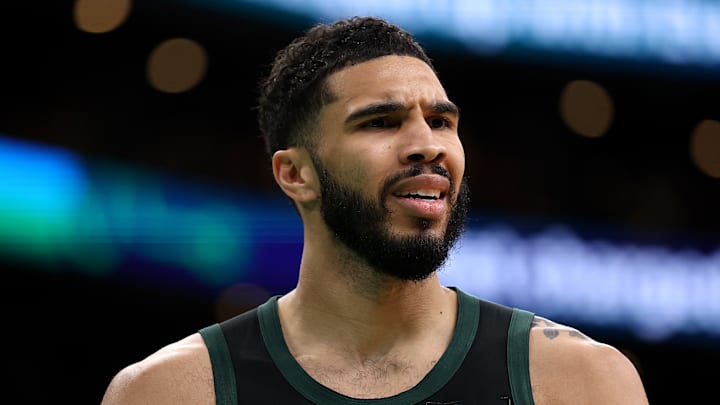In the short time since the Boston Celtics' season came to an end, it's been almost impossible to avoid discussion centered around potential trades. That's standard practice, right? A team underachieves, and the next step is to figure out how to improve the roster and avoid such disappointment in the future.
Well, in the Celtics' case, that isn't really the story. These discussions would be happening even if they'd gone all the way to win Banner 19 this spring.
That's the harsh reality that the league's latest collective bargaining agreement update creates for high-spending teams like Boston.
Under the new CBA, the further above the NBA's soft salary cap a team spends, the greater the penalties become. There are three tiers of overspenders: luxury tax teams, first apron teams, and second apron teams.
Next season, Spotrac projects the luxury tax threshold to be at $189.7 million, the first apron threshold at $195.9 million, and the second apron threshold at $207.8 million.
Which tier are the Celtics in?
As of today, May 27, 2025, the Celtics are projected to have $227.8 million in salary on their books in the 2025-26 season. Mind you, that figure doesn't include whatever checks the Cs could cut to unrestricted free agents Al Horford and Luke Kornet, and whichever incoming rookies they draft next month.
If Boston were to stay above the $207.8 million second apron line, it would be their third straight season doing so. It would also be their fourth straight season spending over the salary cap.
What penalties will the Celtics face if they remain above the second apron again?
The NBA's apron system sort of works like a mean rewards program. Just like how your favorite airline might have silver, gold, and platinum tiers, but the rewards are just consequences. Much like many rewards programs, the "perks" from each tier stack the higher you go.
So, with the Celtics being in the highest tier, they not only get the penalties from the second apron, but also the drawbacks of being a luxury tax and first apron team.
Luxury Tax:
The NBA has two different sets of luxury tax rates. There's the standard rate, and then there's a harsher "repeater" rate for teams who exceed the luxury tax line in three out of four seasons.
You'll never guess which one the Celtics are in.
That's right, they'll be paying the repeater rate, which is based on how much they've spent over the luxury tax line. How significant their penalty is is determined by the percentage that they exceed the league's tax bracket for that season.
The tax bracket amount equates to $5 million multiplied by the percentage increase (or decrease) of the salary cap on a year-over-year scale.
Next season's cap will be $154.6 million. This season's was $140.6 million. That is a 10% increase year over year. So, the tax bracket amount will be $5.5 million
The 2025-26 repeater rates are as follows:
- 0-100 percent of tax bracket amount ($187.9M-$193.4M total salary): $ 3.00 for $1 over.
- 100-200 percent ($193.4M-$198.9M): $3.25 for $1
- 200-300 percent ($198.9M-$204.4M): $5:50 for $1
- 400 percent and higher ($204.4M or more): $6.75 plus $0.50 for each additional 100 percent.
So, as of today, the Celtics would be paying $8.75 (6.75 + 4* 0.50) for every $1 that they spend over that luxury tax line. That's an expensive check for ownership, especially a new one, to be cutting.
First Apron:
In addition to the financial penalties of the luxury tax, there are also the basketball penalties of the aprons. The more teams spend, the more difficult it is to build or solidify a contending roster.
The list of penalties for first-apron teams is as follows:
- Lose access to the non-taxpayer mid-level exception or bi-annual exception.
- Not allowed to take back more salary in a trade than they send out.
- Not allowed to acquire a player via sign-and-trade.
- Not allowed to sign a player from the buyout market who was earning more than the non-taxpayer mid-level exception ($12.9 million) before getting waived.
- Not allowed to use preexisting trade exceptions.
Second Apron:
As harsh as the above restrictions are, the second-apron penalties are harsher.
Second apron teams the below penalties, as well as the first-apron penalties:
- Complete loss of any mid-level exception in free agency.
- Not allowed to aggregate contracts in trades.
- Not allowed to send cash in trades.
- Not allowed to acquire players when they sign-and-trade their own free agents elsewhere.
- Not allowed to trade a first-round pick seven years in the future, and that pick falls to the bottom of the first round if a team is over the second apron at least three times in a five-season span.
That last one is key, considering this would be Boston's third straight year as a second-apron team. With how limited spending is now, considering these restrictions, being able to make the most of draft picks is more key than ever.
Having those selections drop to the end of a round could be a backbreaker.
In a perfect world, the Celtics would keep all of their key rotation players and try to be ready for Jayson Tatum's eventual return from his torn Achilles. Unfortunately, we don't live in that world. We live in the one where the Cs are being billed with a plethora of luxury tax payments and met with all of the apron restrictions.
Shedding salary is likely the front office's top priority at the moment, understandably so.
